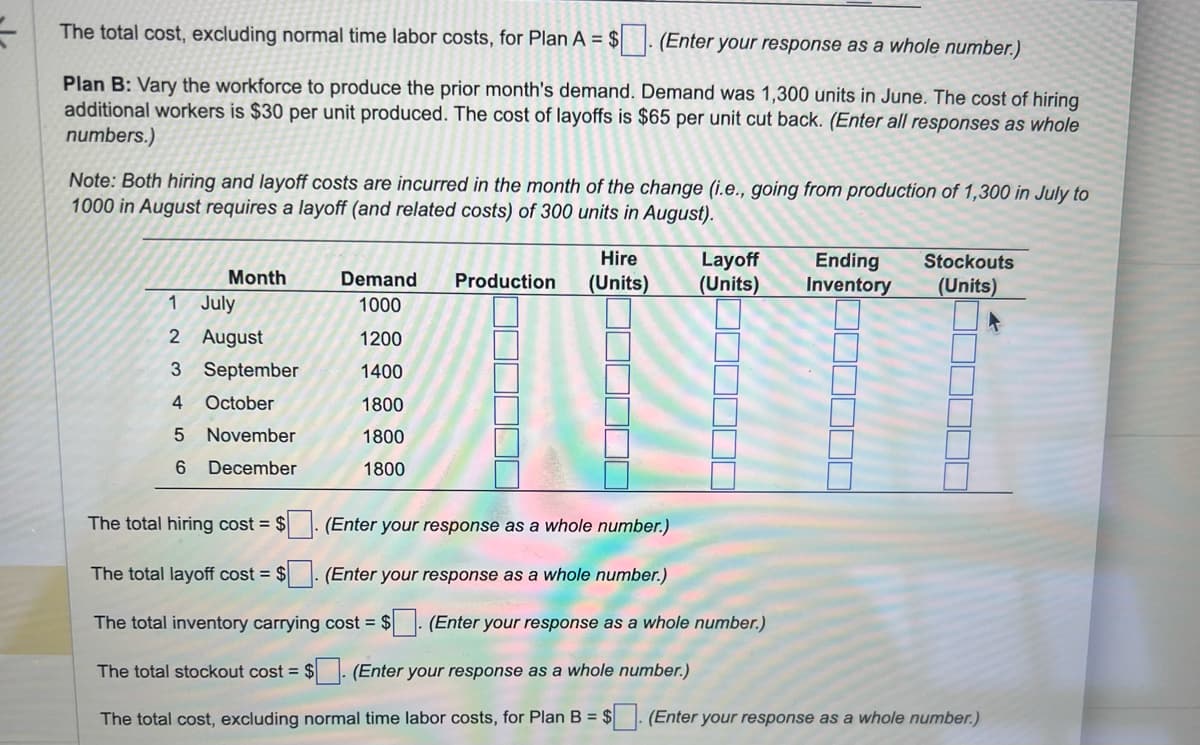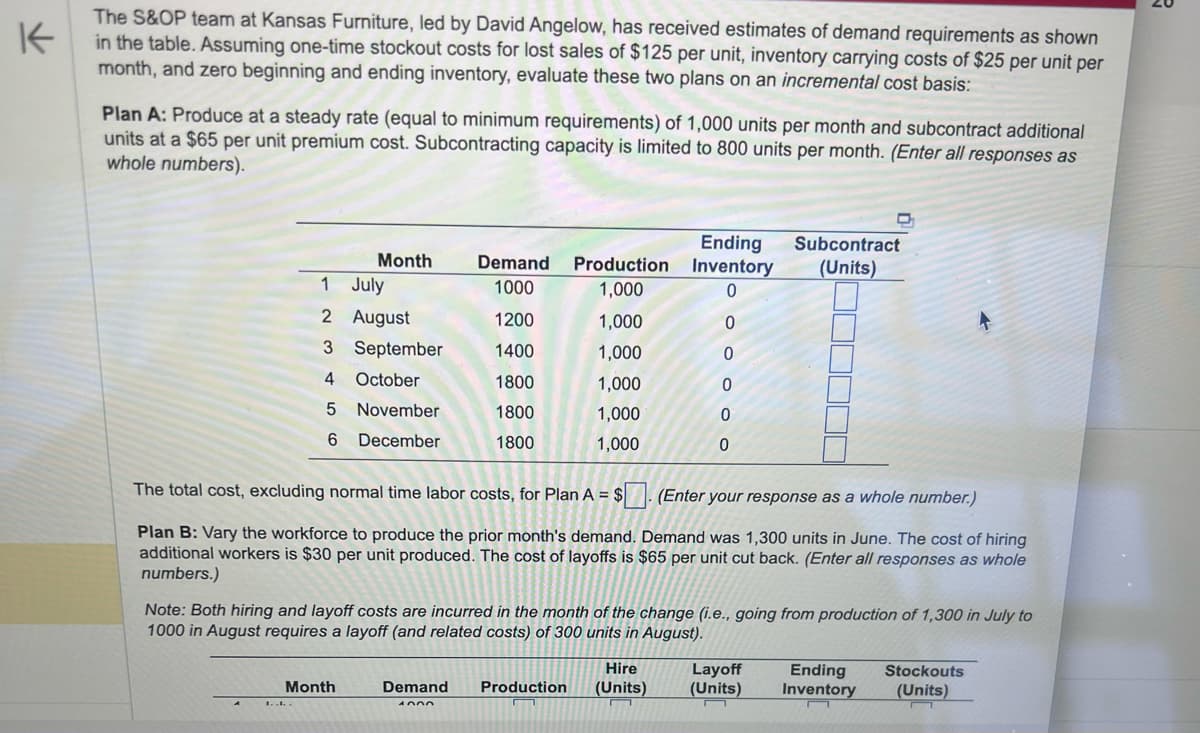The total cost, excluding normal time labor costs, for Plan A = $. (Enter your response as a whole number.) Plan B: Vary the workforce to produce the prior month's demand. Demand was 1,300 units in June. The cost of hiring additional workers is $30 per unit produced. The cost of layoffs is $65 per unit cut back. (Enter all responses as whole numbers.) Note: Both hiring and layoff costs are incurred in the month of the change (i.e., going from production of 1,300 in July to 1000 in August requires a layoff (and related costs) of 300 units in August). Month 1 July 2 August 3 September 4 October 5 November 6 December Demand 1000 1200 1400 1800 1800 1800 Hire Production (Units) The total hiring cost = $ (Enter your response as a whole number.) The total layoff cost = $. (Enter your response as a whole number.) The total inventory carrying cost = $ The total stockout cost = $. (Enter your response as a whole number.) The total cost, excluding normal time labor costs, for Plan B = $ Layoff (Units) (Enter your response as a whole number.) Ending Stockouts Inventory (Units) (Enter your response as a whole number.)
The total cost, excluding normal time labor costs, for Plan A = $. (Enter your response as a whole number.) Plan B: Vary the workforce to produce the prior month's demand. Demand was 1,300 units in June. The cost of hiring additional workers is $30 per unit produced. The cost of layoffs is $65 per unit cut back. (Enter all responses as whole numbers.) Note: Both hiring and layoff costs are incurred in the month of the change (i.e., going from production of 1,300 in July to 1000 in August requires a layoff (and related costs) of 300 units in August). Month 1 July 2 August 3 September 4 October 5 November 6 December Demand 1000 1200 1400 1800 1800 1800 Hire Production (Units) The total hiring cost = $ (Enter your response as a whole number.) The total layoff cost = $. (Enter your response as a whole number.) The total inventory carrying cost = $ The total stockout cost = $. (Enter your response as a whole number.) The total cost, excluding normal time labor costs, for Plan B = $ Layoff (Units) (Enter your response as a whole number.) Ending Stockouts Inventory (Units) (Enter your response as a whole number.)
Practical Management Science
6th Edition
ISBN:9781337406659
Author:WINSTON, Wayne L.
Publisher:WINSTON, Wayne L.
Chapter2: Introduction To Spreadsheet Modeling
Section: Chapter Questions
Problem 21P
Related questions
Question

Transcribed Image Text:The total cost, excluding normal time labor costs, for Plan A = $. (Enter your response as a whole number.)
Plan B: Vary the workforce to produce the prior month's demand. Demand was 1,300 units in June. The cost of hiring
additional workers is $30 per unit produced. The cost of layoffs is $65 per unit cut back. (Enter all responses as whole
numbers.)
Note: Both hiring and layoff costs are incurred in the month of the change (i.e., going from production of 1,300 in July to
1000 in August requires a layoff (and related costs) of 300 units in August).
Month
1
2
3 September
4 October
July
August
5 November
6 December
Demand
1000
1200
1400
1800
1800
1800
Hire
Production (Units)
The total hiring cost = $
The total layoff cost = $
The total inventory carrying
The total stockout cost = $
The total cost, excluding normal time labor costs, for Plan B =
(Enter your response as a whole number.)
(Enter your response as a whole number.)
cost = $
(Enter your response as a whole number.)
Layoff
(Units)
▬▬▬▬▬
(Enter your response as a whole number.)
Ending
Inventory
|||||
Stockouts
(Units)
(Enter your response as a whole number.)

Transcribed Image Text:K
The S&OP team at Kansas Furniture, led by David Angelow, has received estimates of demand requirements as shown
in the table. Assuming one-time stockout costs for lost sales of $125 per unit, inventory carrying costs of $25 per unit per
month, and zero beginning and ending inventory, evaluate these two plans on an incremental cost basis:
Plan A: Produce at a steady rate (equal to minimum requirements) of 1,000 units per month and subcontract additional
units at a $65 per unit premium cost. Subcontracting capacity is limited to 800 units per month. (Enter all responses as
whole numbers).
1
July
2
August
3 September
4 October
5 November
6 December
Month
IL
Month
Demand
1000
1200
1400
1800
1800
1800
Demand
4000
Ending
Production Inventory
1,000
0
1,000
1,000
1,000
1,000
1,000
OOO
0
0
0
0
0
The total cost, excluding normal time labor costs, for Plan A = $. (Enter your response as a whole number.)
Plan B: Vary the workforce to produce the prior month's demand. Demand was 1,300 units in June. The cost of hiring
additional workers is $30 per unit produced. The cost of layoffs is $65 per unit cut back. (Enter all responses as whole
numbers.)
Note: Both hiring and layoff costs are incurred in the month of the change (i.e., going from production of 1,300 in July to
1000 in August requires a layoff (and related costs) of 300 units in August).
D
Subcontract
(Units)
Hire
Layoff
Production (Units) (Units)
Ending
Inventory
Stockouts
(Units)
M
Expert Solution
This question has been solved!
Explore an expertly crafted, step-by-step solution for a thorough understanding of key concepts.
This is a popular solution!
Trending now
This is a popular solution!
Step by step
Solved in 2 steps with 10 images

Recommended textbooks for you

Practical Management Science
Operations Management
ISBN:
9781337406659
Author:
WINSTON, Wayne L.
Publisher:
Cengage,

Practical Management Science
Operations Management
ISBN:
9781337406659
Author:
WINSTON, Wayne L.
Publisher:
Cengage,